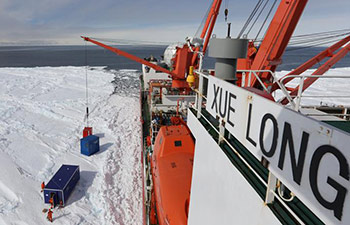LOS ANGELES, Dec. 16 (Xinhua) -- A pair of next-generation GRACE satellites, Gravity Recovery and Climate Experiment Follow-On (GRACE-FO) satellites, is now at Vandenberg Air Force Base, the U.S. state of California, to begin final preparations for launch next spring, NASA has said.
"With this milestone, we are now in position to launch GRACE Follow-On and restart the valuable observations and science that ceased in mid-2017 with the end of the GRACE science mission," Michael Watkins, director of NASA's Jet Propulsion Laboratory (JPL), and GRACE Follow-On science team lead, said in a news release.
After arriving this week at the launch site on California's central coast, the advanced U.S./German Earth research satellites will undergo final tests before being integrated atop a SpaceX Falcon 9 rocket, where they will share a ride to space with five Iridium NEXT communications satellites.
GRACE-FO will provide continuity to the Earth climate data record of the predecessor GRACE, which completed its science mission in October after more than 15 years in orbit.
The twin satellites will be launched into a polar orbit at an altitude of about 500 kilometers. Flying 220 kilometers apart, they will then use a JPL-built microwave ranging system to take continuous, very precise measurements of the variations in the distance between each other, said NASA.
After a few months of in-orbit checkout, GRACE-FO will track changes in the distribution of liquid water, ice and land masses by measuring changes in Earth's gravity field every 30 days.
The next-generation GRACE satellites will essentially measure how much mass is gained or lost each month on the continents, in the oceans, and in the ice sheets. These data will improve scientific understanding of Earth system processes and the accuracy of environmental monitoring and forecasts.
The continuous movement of masses of water, ice, air and the solid Earth that GRACE-FO will track is driven by Earth system processes.
Each satellite will also carry an instrument called an atmospheric limb sounder to measure how much signals from GPS satellites are distorted by the atmosphere.
While similar to their predecessor GRACE satellites, GRACE-FO incorporates design upgrades gleaned from 15 years of GRACE operations that will improve satellite performance, reliability and mission operations.
GRACE-FO will also fly a more precise inter-satellite laser ranging instrument, which will be tested for use in future generations of GRACE-like missions.
GRACE-FO will extend GRACE's legacy of scientific achievements, which range from tracking mass changes of Earth's polar ice sheets and estimating global groundwater changes, to measuring the mass changes of large earthquakes and inferring changes in deep ocean currents, a driving force in climate.
To date, GRACE observations have been used in more than 4,300 research publications. GRACE-FO is planned to fly at least five years.

















